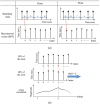Measurement of pulse transit time using ultra-wideband radar
- PMID: 33427703
- PMCID: PMC8543252
- DOI: 10.3233/THC-202626
Measurement of pulse transit time using ultra-wideband radar
Abstract
Background: The pulse transit time is an important factor that can be used to estimate the blood pressure indirectly. In many studies, pressures in the artery near and far from the heart are measured or the electrocardiogram and photoplethysmography are used to calculate the pulse transit time. In other words, the so-called contact measurements have been mainly used in these studies.
Objective: In this paper, a new method based on radar technology to measure the pulse transit time in a non-contact manner is proposed.
Methods: Radar pulses were simultaneously emitted to the chest and the wrist, and the reflected pulses were accumulated. Heartbeats were extracted by performing principal component analysis on each time series belonging to the accumulated pulses. Then, the matched heartbeat pairs were found among the heartbeats obtained from the chest and wrist and the time delay between them, i.e. the pulse transit time, was obtained.
Results: By comparing the pulse transit times obtained by the proposed method with those obtained by conventional methods, it is confirmed that the proposed method using the radar can be used to obtain the pulse transit time in a non-contact manner.
Keywords: Ultra-wide band; heartbeat; impulse radar; principal component analysis; pulse transit time.
Conflict of interest statement
The authors declare no conflict of interests.
Figures







References
-
- Zhang Q, Shi Y, Teng D, Dinh A, Ko SB, Chen L, Basran J, Bello-Haas VD, Choi Y. Pulse transit time-based blood pressure estimation using hilbert-huang transform. Conf Proc IEEE Eng Med Biol Soc. 2009; 2009: 1785–1788. - PubMed
-
- Ding XR, Zhao N, Yang GZ, Pettigrew RI, Lo B, Miao F, et al. Continuous blood pressure measurement from invasive to unobtrusive: celebration of 200th birth anniversary of Carl Ludwig. IEEE J Biomed Health Inform. 2016; 20(6): 1455–1465. - PubMed
-
- Lin H, Xu W, Guan N, Ji D, Wei Y, Yi W. Noninvasive and continuous blood pressure monitoring using wearable body sensor networks. IIEEE Intell Syst. 2015; 30(6): 38–48.
MeSH terms
LinkOut - more resources
Full Text Sources

